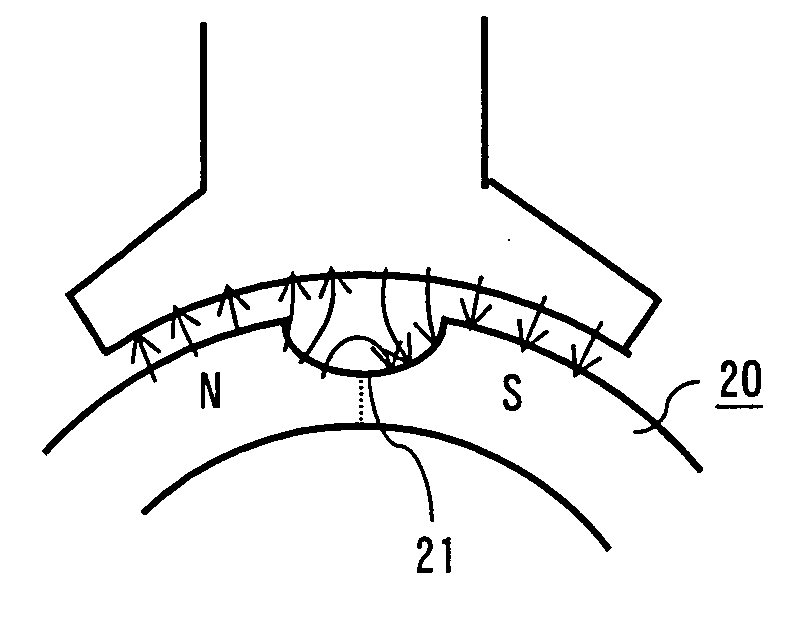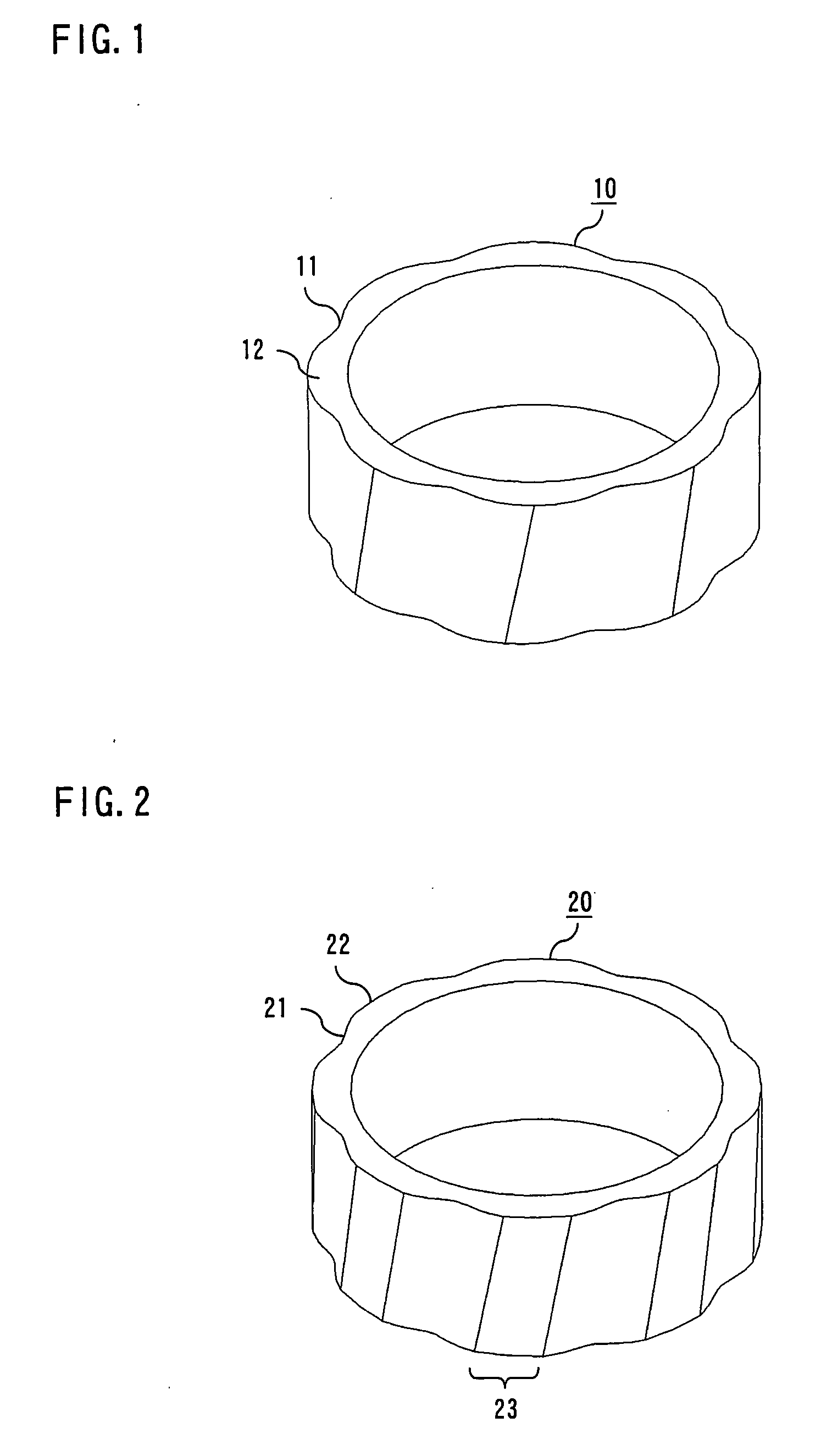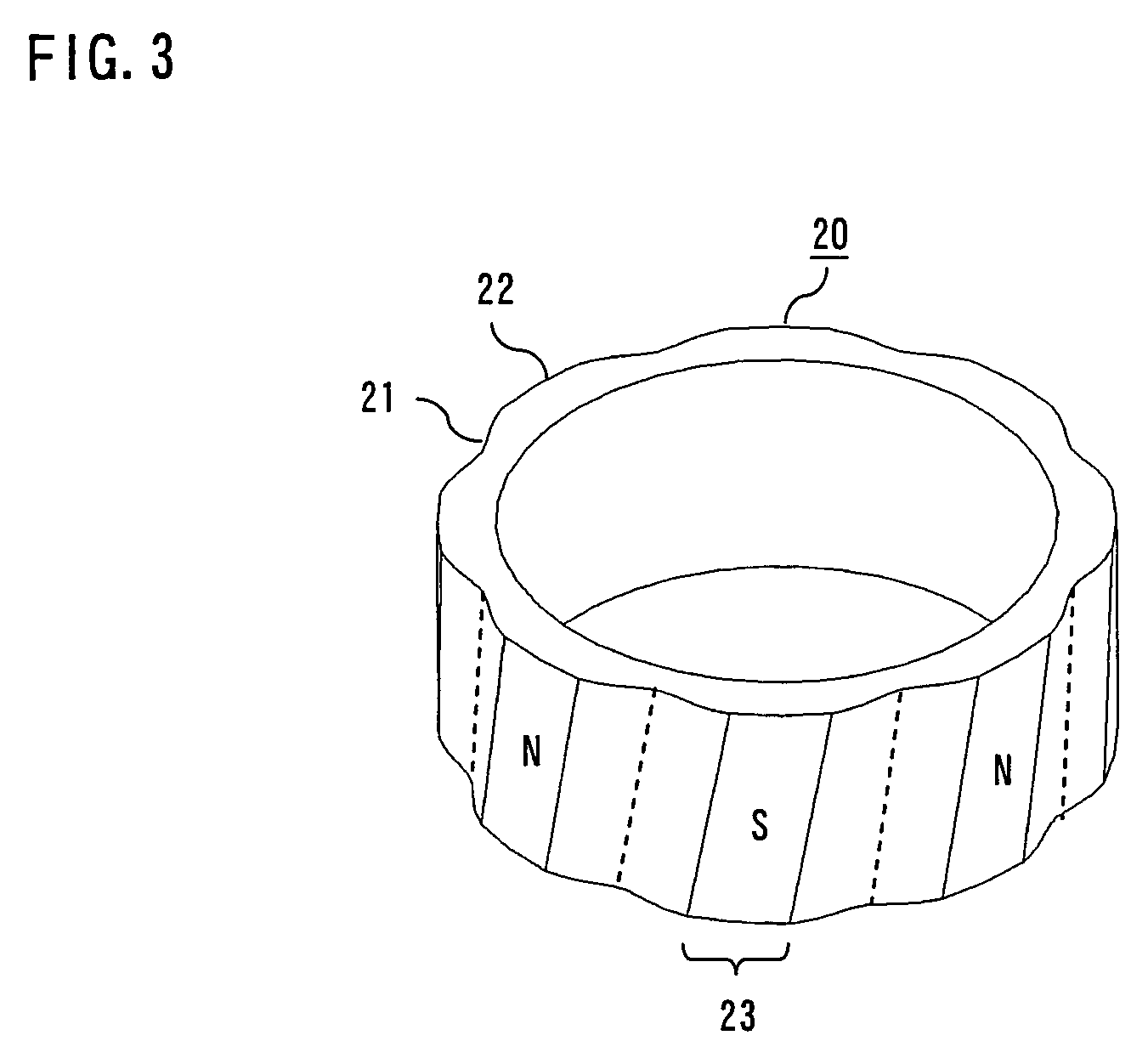Sintered ring magnet
a sintered ring magnet and ring magnet technology, which is applied in the direction of magnetic circuit rotating parts, magnetic circuit shapes/forms/construction, magnetic bodies, etc., can solve the problems of inability to manufacture compact high-power motors, inability to sufficiently reduce cogging torque, and weak magnetic force produced by bonded magnets, so as to reduce the distortion of magnetization distribution
- Summary
- Abstract
- Description
- Claims
- Application Information
AI Technical Summary
Benefits of technology
Problems solved by technology
Method used
Image
Examples
first embodiment
[0060]FIG. 1 is a perspective view of a sintered ring magnet 10 having a ring shape according to a first embodiment of the invention. The sintered ring magnet 10 is a magnet containing neodymium (Nd), iron (Fe) and boron (B) as main components. A generally cylindrical outer surface of the sintered ring magnet 10 is corrugated with alternating hollows 11 and protrusions 12 formed along the sintered ring magnet 10. The hollows 11 and the protrusions 12 are formed at regular intervals around the generally cylindrical outer surface of the sintered ring magnet 10. In the example shown in FIG. 1, the sintered ring magnet 10 has eight each hollows 11 and protrusions 12 alternately formed at specific angular intervals (45°).
[0061] The hollows 11 and the protrusions 12 are formed in parallel lines skewed by a specific inclination angle (skew angle) with respect to an axial direction of the sintered ring magnet 10. Magnetic poles of the sintered ring magnet 10 are formed by skewed magnetizat...
second embodiment
[0069] A sintered ring magnet according to a second embodiment of the invention is also a ring-shaped sintered magnet containing neodymium, iron and boron as main components and having corrugations (protrusions and hollows) formed on a generally cylindrical outer surface like the sintered ring magnet 10 of the first embodiment. The protrusions and the hollows are formed in parallel lines skewed by a specific inclination angle (skew angle) about a longitudinal axis of the ring magnet. Magnetic poles of the ring magnet are formed along the corrugations with boundaries between the adjacent magnetic poles located in the individual hollows. What is characteristic of the sintered ring magnet of this embodiment is that each of the protrusions formed on the generally cylindrical outer surface of the ring magnet constitutes part of an imaginary cylindrical shape which defines an outermost surface of the ring magnet. Thus, as viewed along the longitudinal axis (central axis) of the ring magne...
third embodiment
[0073]FIG. 2 is a perspective view of a sintered ring magnet 20 according to a third embodiment of the invention. The sintered ring magnet 20 of this embodiment is a sintered magnet containing neodymium, iron and boron as main components like the sintered ring magnet 10 of the first embodiment. A generally cylindrical outer surface of the sintered ring magnet 20 is corrugated with alternating hollows 21 and protrusions 22 formed along the sintered ring magnet 20. The hollows 21 and the protrusions 22 are formed in parallel lines skewed by a specific inclination angle (skew angle) with respect to an axial direction of the sintered ring magnet 20.
[0074] As shown in FIG. 3, magnetic poles of the sintered ring magnet 20 are formed such that the magnetic poles are aligned parallel to the hollows 21 and the protrusions 22 at the same skew angle with respect to the axial direction of the sintered ring magnet 20. Boundaries of these magnetic poles (shown by broken lines in FIG. 2) are loca...
PUM
| Property | Measurement | Unit |
|---|---|---|
| particle size | aaaaa | aaaaa |
| temperatures | aaaaa | aaaaa |
| temperatures | aaaaa | aaaaa |
Abstract
Description
Claims
Application Information
 Login to View More
Login to View More - R&D
- Intellectual Property
- Life Sciences
- Materials
- Tech Scout
- Unparalleled Data Quality
- Higher Quality Content
- 60% Fewer Hallucinations
Browse by: Latest US Patents, China's latest patents, Technical Efficacy Thesaurus, Application Domain, Technology Topic, Popular Technical Reports.
© 2025 PatSnap. All rights reserved.Legal|Privacy policy|Modern Slavery Act Transparency Statement|Sitemap|About US| Contact US: help@patsnap.com



